Transitional Words and Phrases
One of your primary goals as a writer is to present ideas in a clear and understandable way. To help readers move through your complex ideas, you want to be intentional about how you structure your paper as a whole as well as how you form the individual paragraphs that comprise it. In order to think through the challenges of presenting your ideas articulately, logically, and in ways that seem natural to your readers, check out some of these resources: Developing a Thesis Statement , Paragraphing , and Developing Strategic Transitions: Writing that Establishes Relationships and Connections Between Ideas.
While clear writing is mostly achieved through the deliberate sequencing of your ideas across your entire paper, you can guide readers through the connections you’re making by using transitional words in individual sentences. Transitional words and phrases can create powerful links between your ideas and can help your reader understand your paper’s logic.
In what follows, we’ve included a list of frequently used transitional words and phrases that can help you establish how your various ideas relate to each other. We’ve divided these words and phrases into categories based on the common kinds of relationships writers establish between ideas.
Two recommendations: Use these transitions strategically by making sure that the word or phrase you’re choosing matches the logic of the relationship you’re emphasizing or the connection you’re making. All of these words and phrases have different meanings, nuances, and connotations, so before using a particular transitional word in your paper, be sure you understand its meaning and usage completely, and be sure that it’s the right match for your paper’s logic. Use these transitional words and phrases sparingly because if you use too many of them, your readers might feel like you are overexplaining connections that are already clear.
Categories of Transition Words and Phrases
Causation Chronology Combinations Contrast Example
Importance Location Similarity Clarification Concession
Conclusion Intensification Purpose Summary
Transitions to help establish some of the most common kinds of relationships
Causation– Connecting instigator(s) to consequence(s).
accordingly as a result and so because
consequently for that reason hence on account of
since therefore thus
Chronology– Connecting what issues in regard to when they occur.
after afterwards always at length during earlier following immediately in the meantime
later never next now once simultaneously so far sometimes
soon subsequently then this time until now when whenever while
Combinations Lists– Connecting numerous events. Part/Whole– Connecting numerous elements that make up something bigger.
additionally again also and, or, not as a result besides even more
finally first, firstly further furthermore in addition in the first place in the second place
last, lastly moreover next second, secondly, etc. too
Contrast– Connecting two things by focusing on their differences.
after all although and yet at the same time but
despite however in contrast nevertheless nonetheless notwithstanding
on the contrary on the other hand otherwise though yet
Example– Connecting a general idea to a particular instance of this idea.
as an illustration e.g., (from a Latin abbreviation for “for example”)
for example for instance specifically that is
to demonstrate to illustrate
Importance– Connecting what is critical to what is more inconsequential.
chiefly critically
foundationally most importantly
of less importance primarily
Location– Connecting elements according to where they are placed in relationship to each other.
above adjacent to below beyond
centrally here nearby neighboring on
opposite to peripherally there wherever
Similarity– Connecting to things by suggesting that they are in some way alike.
by the same token in like manner
in similar fashion here in the same way
likewise wherever
Other kinds of transitional words and phrases Clarification
i.e., (from a Latin abbreviation for “that is”) in other words
that is that is to say to clarify to explain
to put it another way to rephrase it
granted it is true
naturally of course
finally lastly
in conclusion in the end
to conclude
Intensification
in fact indeed no
of course surely to repeat
undoubtedly without doubt yes
for this purpose in order that
so that to that end
to this end
in brief in sum
in summary in short
to sum up to summarize


Improving Your Writing Style
This is an accordion element with a series of buttons that open and close related content panels.
Clear, Concise Sentences
Use the active voice
Put the action in the verb
Tidy up wordy phrases
Reduce wordy verbs
Reduce prepositional phrases
Reduce expletive constructions
Avoid using vague nouns
Avoid unneccessarily inflated words
Avoid noun strings
Connecting Ideas Through Transitions
Using Transitional Words and Phrases
Writing Studio
Common transition words and phrases.
In an effort to make our handouts more accessible, we have begun converting our PDF handouts to web pages. Download this page as a PDF: Transitions Return to Writing Studio Handouts
Transitions clarify the logic of your argument by orienting your reader as you develop ideas between sentences and paragraphs. These tools should alert readers to shifts in your argument while and also maintain the smoothness and clarity of your prose. Below, you’ll find some of the most commonly used transition categories and examples of each. Depending on the example, these suggestions may be within sentences or at the beginning of sentences.
Transitions by Category
1. addition.
Use when presenting multiple ideas that flow in the same direction, under the same heading/ idea also, another, finally, first, first of all, for one thing, furthermore, in addition, last of all, likewise, moreover, next, and, second, the third reason
2. Sequence/ Order
Use to suggest a temporal relationship between ideas; places evidence in sequence first, second (etc.), next, last, finally, first of all, concurrently, immediately, prior to, then, at that time, at this point, previously, subsequently, and then, at this time, thereafter, previously, soon, before, after, followed by, after that, next, before, after, meanwhile, formerly, finally, during
3. Contrast
Use to demonstrate differences between ideas or change in argument direction but, however, in contrast, on the other hand, on the contrary, yet, differ, difference, balanced against, differing from, variation, still, on the contrary, unlike, conversely, otherwise, on the other hand, however
4. Exception
Use to introduce an opposing idea however, whereas, on the other hand, while, instead, in spite of, yet, despite, still, nevertheless, even though, in contrast, but, but one could also say…
5. Comparison
Use to demonstrate similarities between ideas that may not be under the same subject heading or within the same paragraph like, likewise, just, in a different way / sense, whereas, like, equally, in like manner, by comparison, similar to, in the same way, alike, similarity, similarly, just as, as in a similar fashion, conversely
6. Illustration
Use to develop or clarify an idea, to introduce examples, or to show that the second idea is subordinate to the first for example, to illustrate, on this occasion, this can be seen, in this case, specifically, once, to illustrate, when/where, for instance, such as, to demonstrate, take the case of, in this case
7. Location
Use to show spatial relations next to, above, below, beneath, left, right, behind, in front, on top, within
8. Cause and Effect
Use to show that one idea causes, or results from, the idea that follows or precedes it because, therefore, so that, cause, reason, effect, thus, consequently, since, as a result, if…then, result in
9. Emphasis
Use to suggest that an idea is particularly important to your argument important to note, most of all, a significant factor, a primary concern, a key feature, remember that, pay particular attention to, a central issue, the most substantial issue, the main value, a major event, the chief factor, a distinctive quality, especially valuable, the chief outcome, a vital force, especially relevant, most noteworthy, the principal item, above all, should be noted
10. Summary or Conclusion
Use to signal that what follows is summarizing or concluding the previous ideas; in humanities papers, use these phrases sparingly. to summarize, in short, in brief, in sum, in summary, to sum up, in conclusion, to conclude, finally
Some material adapted from Cal Poly Pomona College Reading Skills Program and “ Power Tools for Technical Communication .”
Writing Effective Sentence Transitions (Advanced)
Transitions are the rhetorical tools that clarify the logic of your argument by orienting your reader as you develop ideas between sentences and paragraphs. The ability to integrate sentence transitions into your prose, rather than simply throwing in overt transition signals like “in addition,” indicates your mastery of the material. (Note: The visibility of transitions may vary by discipline; consult with your professor to get a better sense of discipline or assignment specific expectations.)
Transition Signals
Transition signals are words or phrases that indicate the logic connecting sets of information or ideas. Signals like therefore, on the other hand, for example, because, then, and afterwards can be good transition tools at the sentence and paragraph level. When using these signals, be conscious of the real meaning of these terms; they should reflect the actual relationship between ideas.
Review Words
Review words are transition tools that link groups of sentences or whole paragraphs. They condense preceding discussion into a brief word or phrase. For example: You’ve just completed a detailed discussion about the greenhouse effect. To transition to the next topic, you could use review words like “this heat-trapping process” to refer back to the green house effect discussion. The relative ability to determine a cogent set of review words might signal your own understanding of your work; think of review words as super-short summaries of key ideas.
Preview words
Preview words condense an upcoming discussion into a brief word or phrase. For example: You’ve just explained how heat is trapped in the earth’s atmosphere. Transitioning to the theory that humans are adding to that effect, you could use preview words like “sources of additional CO2 in the atmosphere include” to point forward to that discussion.
Transition Sentences
The strongest and most sophisticated tools, transition sentences indicate the connection between the preceding and upcoming pieces of your argument. They often contain one or more of the above transition tools. For example: You’ve just discussed how much CO2 humans have added to the atmosphere. You need to transition to a discussion of the effects. A strong set of transition sentences between the two sections might sound like this:
“These large amounts of CO2 added to the atmosphere may lead to a number of disastrous consequences for residents of planet earth. The rise in global temperature that accompanies the extra CO2 can yield effects as varied as glacial melting and species extinction.”
In the first sentence, the review words are “These large amounts of CO2 added to the atmosphere”; the preview words are “number of disastrous consequences”; the transition signals are “may lead to.” The topic sentence of the next paragraph indicates the specific “disastrous consequences” you will discuss.
If you don’t see a way to write a logical, effective transition between sentences, ideas or paragraphs, this might indicate organizational problems in your essay; you might consider revising your work.
Some material adapted from Cal Poly Pomona College Reading Skills Program and “ Power Tools for Technical Communication .”
Last revised: 07/2008 | Adapted for web delivery: 05/2021
In order to access certain content on this page, you may need to download Adobe Acrobat Reader or an equivalent PDF viewer software.
- Help Articles
Transitional Words and Phrases in Fiction: 4 Writing Tips
Transitional words and phrases in fiction, as in nonfiction, aid smooth movement between paragraphs, chapters, scenes, ideas, locations, times and characters. Effective transitions act as bridges that move the reader logically from one point to another, unobtrusively, without awkwardness.
They may use special "transition" words, or they may not, so I've included examples of both methods here. The secret to good transitions is to make them so natural that the reader hardly notices them. The following transitional techniques will help.
Transitional Words and Phrases that Signal Time
However your story unfolds in time (over hours, days, months or years) perhaps the most common type of transition is some transition word or phrase that indicates the amount of time that has passed, such as: A week later, Tom boarded a bus for Winnipeg. In his wonderful novel Brooklyn , Colm Toibin uses this type of transition at the start of many new scenes, with examples such as: One day at dinnertime Rose... (p. 22).
"One day" is non-specific, but nevertheless indicates that a number of days have passed and that the new scene takes place at dinnertime. In another example from Brooklyn a new scene opens, One morning, when she had been there for three weeks and was on her fourth... (65). From this we learn that the scene takes place in the morning and that three weeks have passed since the character started her new job.
Other examples:
- At the same time
- For two weeks
- For a month he did not visit, see, plan, etc.
- In the morning
- After lunch
- The next day
- Later that evening
- When the sun sank
- The following Tuesday
- A week later
- Months passed
- At the appointed time
- The next time they met
- When they arrived home
- As they approached
- In the year 2004
- It took a month, but
- On the first sunny day
Transitional Words and Phrases that Shift Location
Another transitional method is to shift to a new location for the next scene. In Brooklyn, we find three good examples of this. On page 33, the scene opens with: Rose took the day off from work and travelled with her to Dublin. This indicates that the scene has shifted from their hometown to Dublin.
At the top of page 38, another scene opens: They moved around the city centre, slowly becoming more relaxed... This indicates that the scene takes place in Liverpool and that the protagonist, Eilis, and her brother walk around the city, as they slowly get comfortable with each other. Then, halfway through page 39, another new scene begins: It was difficult to carry her suitcases down the narrow stairs of the liner and Eilis had to move sideways on the corridor as she followed the signs that led to her berth.
The previous scene ends with a conversation between Eilis and her brother, so this single sentence at the start of this new scene serves as a cleverly written transition that not only indicates her new location (on board the ocean liner) but also shows a shift in her mood, as she must suddenly cope on her own in this foreign setting. Study the novel Brooklyn for numerous examples of skillful writing transitions.
- They boarded the plane, train, bus, etc.
- The hotel was
- She walked alone into the dark streets
- When the train stopped
- She took a position in
- The cabin was situated
- Farther along Barnett Street
- The taxi inched through traffic
- They sat hunched on the steps of the
- Across from the temple
- When they reached
- In the hospital corridor
Transitional Words and Phrases that Change Point of View
In a story with multiple points of view , transitional words may be used to move smoothly from one character's point of view to another. For example, two characters may meet on a bus and begin a conversation in one character's POV. When the scene ends and the second character gets off the bus, the story may continues in his or her point of view, thus creating a natural transition from one perspective to another.
At the end of a chapter, a character named Sophia may plan to visit her grandmother. The chapter then ends with Sophia getting in her car to make the drive to her grandmother's house. The next chapter might open in the grandmother's point of view at the house, when she opens the door to let Sophia in. Chapter transitions may or may not use transitional phrases, but the general feel is that of change as a result of some prior happening.
- In spite of his father's warning, Joseph carried the...
- Although Alexa was twenty-eight when her father died...
- When Samantha woke...
- In reality, Jason's car was old, and black and hot inside
- Regardless of the heat, he had waited in line three hours for tickets
- To celebrate, Maxine purchased a bottle of...
- Despite his need to see her again, he would leave in the morning
- When the time came, Thomas met his guests in the hallway
- On the whole, Alice enjoyed being alone
- As usual, Jackson was late. He rushed...
- Later, they sat at a small table in the corner, and Eliza ...
- Because they had no future, she...
- Robert had a restless night
- Geneva sometimes wondered why...
Transitional Words and Phrases that Alter the Pace
You may also write transitions using speech or actions that accelerate or slow the pace of your story. For example, John bolted from the car and up the front steps of the house, has a much different effect than this opening: John slipped from the car and checked to make sure all the doors were locked. He stopped to watch a woman pushing a baby carriage pass, on the sidewalk, and then he made his way up the front steps. In this manner, a transition will not only signal a leap in time, but also a change in urgency or mood.
- Not daring to look back, she ran toward the lights (quickens the pace)
- To avoid them, he shuffled from room to room (slows)
- "Under the new rules," he drawled (slows)
- "You silly fool," he whispered. "Do you want to get us killed?" (quickens)
- He pushed to the front of the crowd to see (quickens)
- As a consequence, the weight of the news bore down on him (slows)
- "We have hours to wait," she said (slows)
- With languid ease, Blanche rolled over (slows)
- Peter ducked behind the wall and held his breath (quickens)
Ineffective Writing Transitions
There are also a number of ways beginners write transitions that attract the wrong kind of attention. One common error is to tell readers too much. For example, if one scene ends with Rachel deciding to see her sister to ask for a loan, the next scene should not begin: When Rachel arrived at her sister's house to borrow the thousand dollars she needed to pay Max by midnight...
Write only what moves the plot forward. Some transitions are unnecessary. For example, if someone plans to fly from one city to another, a transitional phrase such as They drove her to the airport and waited as she checked her luggage is unnecessary. Unless something important will happen at the airport, it is better to make filmic cuts, jumping from one location to another with a transitional phrase, avoiding all the details between, such as: Eight hours later, she had cleared customs and was settled in the back of a Paris limousine.
The options for writing effective transitions are numerous. Read widely and develop the habit of analyzing how other writers move between scenes, and which transitional words they use. Then aim to develop fresh constructions of your own.
Review a novel you admire and look at the opening of any chapter after the first one. Does it open with a transitional word or phrase?
Now examine two back-to-back scenes and note which transitional words and phrases join them. What makes these transitions effective?
Related Links of Interest
A long and well organized list of transition words from the University of Wisconsin Writing Center
And from Michigan State University
More Creative Writing Help
- Participles: Bothersome Verbs to Avoid
- Avoiding Passive Verbs
- Tight Writing Gets Published
- Creative Writing Help
- Transitional Words
Search this site:
YOUR STORIES
Page 47
SHORT STORY ANTHOLOGY
MORE GOOD READS
About Contact Advertise Privacy Policy & Disclaimer
© Copyright 2008 - 2022 Be-A-Better-Writer.com All Rights Reserved
EnglishComposition.Org
Be a Better Writer
Transition Words and Phrases
Transition words create cohesion and improve writing flow, helping audiences stay focused on your argument or narrative as you move between sentences , paragraphs, or sections of your work.

Without transition words and phrases, writing can feel like trying to move across a broken bridge as you navigate a series of unconnected ideas. But writing that uses well-placed transitional words makes the relationship between the ideas clearer and the journey smoother.
Transition words can be categorized based on the way they function. These different types of transitional words and phrases signal different relationships between ideas. Knowing how to use a variety of transitional devices will help your readers better understand and be convinced by what you have to say.
Below is a list of transition words organized by function, followed by examples of how using different transitional phrases creates different meanings.
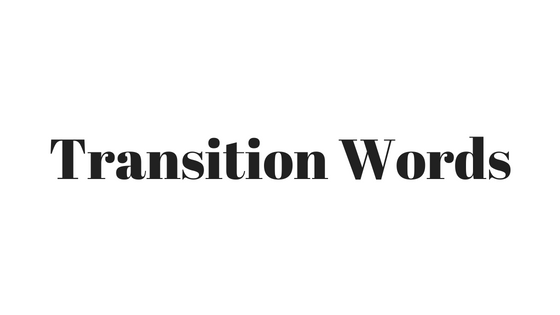
- also
- equally important
- furthermore
- in addition
- additionally
- to continue
- on top of that
- what's more
- first, second, third
- in comparison
- compared to
- nevertheless
- similarly
- vis a vis
- in the same vein
- comparatively
- equally
Contrasting
- although
- however
- in contrast
- on the contrary
- on the other hand
- albeit
- then again
- rather
- conversely
- besides
- beyond that
- behind
- below
- on the left/right
- outside
- within
- underneath
- in front of
- in the middle of
Conclusions
- consequently
- in conclusion
- in summary
- therefore
- accordingly
- thus
- to sum up
- as a result
- hence
- before
- earlier
- first/second/third
- soon after
- to begin with
- at the same time
- all of a sudden
- at this time
- since then
Clarification
- in other words
- that is to say
- to clarify
- to put it another way
- specifically
- to illustrate
- including
- in fact
- case in point
- for example
- to illustrate
- for instance
- e.g.,
- specifically
- to demonstrate
- case in point
- as in
- just as
- granted that
- in spite of
- although this may be true
- admittedly
- despite
- even though
- it's true that
- notwithstanding
- understandably
Cause / Effect
- in effect
- since
- accordingly
- the consequence is
- as a result
- for this reason
- in conclusion
- consequently
- due to
- this suggests
- we find, then
- this implies
Examples of Transition Words in Use
This first example shows how transitional phrases improve the flow of an otherwise dense, technical document. Notice how the inclusion of four small words makes the paragraph much clearer
No transition words:
Proper compression of audio files and projects is an important step to ensuring equal gain throughout your project. Non-compressed audio files can have a range of volumes. Dramatic shifts in volume can cause undue stress on listeners. This manual will model several ways to properly compress audio files before export.
With transition words:
Proper compression of audio files and projects is an important step to ensuring equal gain throughout your project. For example , non-compressed audio files can have a range of volumes. Moreover , dramatic shifts in volume can cause undue stress on listeners. To help you avoid such issues , this manual will model several ways to properly compress audio files before export.
The next example comes from literary scholar Hester Blum’s “The Prospect of Oceanic Studies,” and it demonstrates a situation where although the text is comprehensible without the transition words, adding them makes the sentences easier to follow and overall more pleasant to read.
No transition words
Seamen… were alienated both from their labor and from the privileges of national belonging. These conditions of isolation and distance granted sailors certain benefits over other laboring groups, such as mill workers or farmers. One such advantage is the uncommon extent of literacy among seamen.
With transition words
Seamen… were alienated both from their labor and from the privileges of national belonging. Yet these conditions of isolation and distance granted sailors certain benefits over other laboring groups, such as mill workers or farmers. One such advantage, for example , is the uncommon extent of literacy among seamen.
This next example from Malcolm Gladwell shows how even a single transition word can add nuance to a sentence. In this case, the transition word but highlights the drama in Bannister's attempt to stand in contrast to history.
No transition word
The four-minute barrier had daunted runners for generations; Bannister intended to break through it so that others might follow
With transition word
The four-minute barrier had daunted runners for generations, but Bannister intended to break through it so that others might follow.
Going forward, notice the transition words and phrases used by your favorite writers. Pay particular attention to the way they use transition words to facilitate their arguments and help bring clarity to their ideas.

Down and Dirty Tips: Narrative and Descriptive Essays: Narrative Transitions
- Narrative Start
- Descriptive Start
- Narrative Organization
- Descriptive Organization
- Narrative Transitions
- Descriptive Transitions
Adding Transitions: Narrative Essay
Narrative Essay
Narrative (Timeline) Transitions
- << Previous: Adding Transitions
- Next: Descriptive Transitions >>
- Last Updated: Oct 23, 2023 11:02 AM
- URL: https://spcollege.libguides.com/narrative_descriptive
Some experts argue that focusing on individual actions to combat climate change takes the focus away from the collective action required to keep carbon levels from rising. Change will not be effected, say some others, unless individual actions raise the necessary awareness.
While a reader can see the connection between the sentences above, it’s not immediately clear that the second sentence is providing a counterargument to the first. In the example below, key “old information” is repeated in the second sentence to help readers quickly see the connection. This makes the sequence of ideas easier to follow.
Sentence pair #2: Effective Transition
Some experts argue that focusing on individual actions to combat climate change takes the focus away from the collective action required to keep carbon levels from rising. Other experts argue that individual actions are key to raising the awareness necessary to effect change.
You can use this same technique to create clear transitions between paragraphs. Here’s an example:
Some experts argue that focusing on individual actions to combat climate change takes the focus away from the collective action required to keep carbon levels from rising. Other experts argue that individual actions are key to raising the awareness necessary to effect change. According to Annie Lowery, individual actions are important to making social change because when individuals take action, they can change values, which can lead to more people becoming invested in fighting climate change. She writes, “Researchers believe that these kinds of household-led trends can help avert climate catastrophe, even if government and corporate actions are far more important” (Lowery).
So, what’s an individual household supposed to do?
The repetition of the word “household” in the new paragraph helps readers see the connection between what has come before (a discussion of whether household actions matter) and what is about to come (a proposal for what types of actions households can take to combat climate change).
Sometimes, transitional words can help readers see how ideas are connected. But it’s not enough to just include a “therefore,” “moreover,” “also,” or “in addition.” You should choose these words carefully to show your readers what kind of connection you are making between your ideas.
To decide which transitional word to use, start by identifying the relationship between your ideas. For example, you might be
- making a comparison or showing a contrast Transitional words that compare and contrast include also, in the same way, similarly, in contrast, yet, on the one hand, on the other hand. But before you signal comparison, ask these questions: Do your readers need another example of the same thing? Is there a new nuance in this next point that distinguishes it from the previous example? For those relationships between ideas, you might try this type of transition: While x may appear the same, it actually raises a new question in a slightly different way.
- expressing agreement or disagreement When you are making an argument, you need to signal to readers where you stand in relation to other scholars and critics. You may agree with another person’s claim, you may want to concede some part of the argument even if you don’t agree with everything, or you may disagree. Transitional words that signal agreement, concession, and disagreement include however, nevertheless, actually, still, despite, admittedly, still, on the contrary, nonetheless .
- showing cause and effect Transitional phrases that show cause and effect include therefore, hence, consequently, thus, so. Before you choose one of these words, make sure that what you are about to illustrate is really a causal link. Novice writers tend to add therefore and hence when they aren’t sure how to transition; you should reserve these words for when they accurately signal the progression of your ideas.
- explaining or elaborating Transitions can signal to readers that you are going to expand on a point that you have just made or explain something further. Transitional words that signal explanation or elaboration include in other words, for example, for instance, in particular, that is, to illustrate, moreover .
- drawing conclusions You can use transitions to signal to readers that you are moving from the body of your argument to your conclusions. Before you use transitional words to signal conclusions, consider whether you can write a stronger conclusion by creating a transition that shows the relationship between your ideas rather than by flagging the paragraph simply as a conclusion. Transitional words that signal a conclusion include in conclusion , as a result, ultimately, overall— but strong conclusions do not necessarily have to include those phrases.
If you’re not sure which transitional words to use—or whether to use one at all—see if you can explain the connection between your paragraphs or sentence either out loud or in the margins of your draft.
For example, if you write a paragraph in which you summarize physician Atul Gawande’s argument about the value of incremental care, and then you move on to a paragraph that challenges those ideas, you might write down something like this next to the first paragraph: “In this paragraph I summarize Gawande’s main claim.” Then, next to the second paragraph, you might write, “In this paragraph I present a challenge to Gawande’s main claim.” Now that you have identified the relationship between those two paragraphs, you can choose the most effective transition between them. Since the second paragraph in this example challenges the ideas in the first, you might begin with something like “but,” or “however,” to signal that shift for your readers.
- picture_as_pdf Transitions
Have a language expert improve your writing
Run a free plagiarism check in 10 minutes, generate accurate citations for free.
- Knowledge Base
- Transition sentences | Tips & examples for clear writing
Transition Sentences | Tips & Examples for Clear Writing
Published on June 9, 2020 by Jack Caulfield . Revised on July 23, 2023.
Clear transitions are crucial to clear writing: They show the reader how different parts of your essay, paper, or thesis are connected. Transition sentences can be used to structure your text and link together paragraphs or sections.
… In this case, the researchers concluded that the method was unreliable.
However , evidence from a more recent study points to a different conclusion . …
Instantly correct all language mistakes in your text
Upload your document to correct all your mistakes in minutes

Table of contents
Transitioning between paragraphs, transitioning to a new section, transitions within a paragraph, other interesting articles.
When you start a new paragraph , the first sentence should clearly express:
- What this paragraph will discuss
- How it relates to the previous paragraph
The examples below show some examples of transition sentences between paragraphs and what they express.
Placement of transition sentences
The beginning of a new paragraph is generally the right place for a transition sentence. Each paragraph should focus on one topic, so avoid spending time at the end of a paragraph explaining the theme of the next one.
The first dissenter to consider is …
However, several scholars dissent from this consensus. The first one to consider is …
Receive feedback on language, structure, and formatting
Professional editors proofread and edit your paper by focusing on:
- Academic style
- Vague sentences
- Style consistency
See an example

While transitions between paragraphs are generally a single sentence, when you start a new section in a longer text, you may need an entire transition paragraph. Transitioning to a new section involves summarizing the content of the previous section and expressing how the new one will build upon or depart from it.
For example, the following sentences might be an effective transition for a new section in a literary analysis essay.
Having established that the subjective experience of time is one of Mann’s key concerns in The Magic Mountain , it is now possible to explore how this theme facilitates the novel’s connection with World War I. The war itself is not narrated in the book, but rather hinted at as something awaiting Castorp beyond the final pages. In this way, Mann links his protagonist’s subjective experience of time to more than just his illness; it is also used to explore the period leading up to the outbreak of war.
As in academic writing generally, aim to be as concise as you can while maintaining clarity: If you can transition to a new section clearly with a single sentence, do so, but use more when necessary.
It’s also important to use effective transitions within each paragraph you write, leading the reader through your arguments efficiently and avoiding ambiguity.
The known-new contract
The order of information within each of your sentences is important to the cohesion of your text. The known-new contract , a useful writing concept, states that a new sentence should generally begin with some reference to information from the previous sentence, and then go on to connect it to new information.
In the following example, the second sentence doesn’t follow very clearly from the first. The connection only becomes clear when we reach the end.
By reordering the information in the second sentence so that it begins with a reference to the first, we can help the reader follow our argument more smoothly.
Note that the known-new contract is just a general guideline. Not every sentence needs to be structured this way, but it’s a useful technique if you’re struggling to make your sentences cohere.

Transition words and phrases
Using appropriate transition words helps show your reader connections within and between sentences. Transition words and phrases come in four main types:
- Additive transitions, which introduce new information or examples
- Adversative transitions, which signal a contrast or departure from the previous text
- Causal transitions, which are used to describe cause and effect
- Sequential transitions, which indicate a sequence
The table below gives a few examples for each type:
Grouping similar information
While transition words and phrases are essential, and every essay will contain at least some of them, it’s also important to avoid overusing them. One way to do this is by grouping similar information together so that fewer transitions are needed.
For example, the following text uses three transition words and jumps back and forth between ideas. This makes it repetitive and difficult to follow.
Rewriting it to group similar information allows us to use just one transition, making the text more concise and readable.
If you want to know more about AI tools , college essays , or fallacies make sure to check out some of our other articles with explanations and examples or go directly to our tools!
- Ad hominem fallacy
- Post hoc fallacy
- Appeal to authority fallacy
- False cause fallacy
- Sunk cost fallacy
College essays
- Choosing Essay Topic
- Write a College Essay
- Write a Diversity Essay
- College Essay Format & Structure
- Comparing and Contrasting in an Essay
(AI) Tools
- Grammar Checker
- Paraphrasing Tool
- Text Summarizer
- AI Detector
- Plagiarism Checker
- Citation Generator
Cite this Scribbr article
If you want to cite this source, you can copy and paste the citation or click the “Cite this Scribbr article” button to automatically add the citation to our free Citation Generator.
Caulfield, J. (2023, July 23). Transition Sentences | Tips & Examples for Clear Writing. Scribbr. Retrieved March 25, 2024, from https://www.scribbr.com/academic-essay/transition-sentences/
Is this article helpful?

Jack Caulfield
Other students also liked, transition words & phrases | list & examples, how to write topic sentences | 4 steps, examples & purpose, academic paragraph structure | step-by-step guide & examples, what is your plagiarism score.
- Skip to main content
Join All-Access Reading…Doors Are Open! Click Here
- All-Access Login
- Freebie Library
- Search this website
Teaching with Jennifer Findley
Upper Elementary Teaching Blog
Transition Words {Interactive Notebook} Freebie!
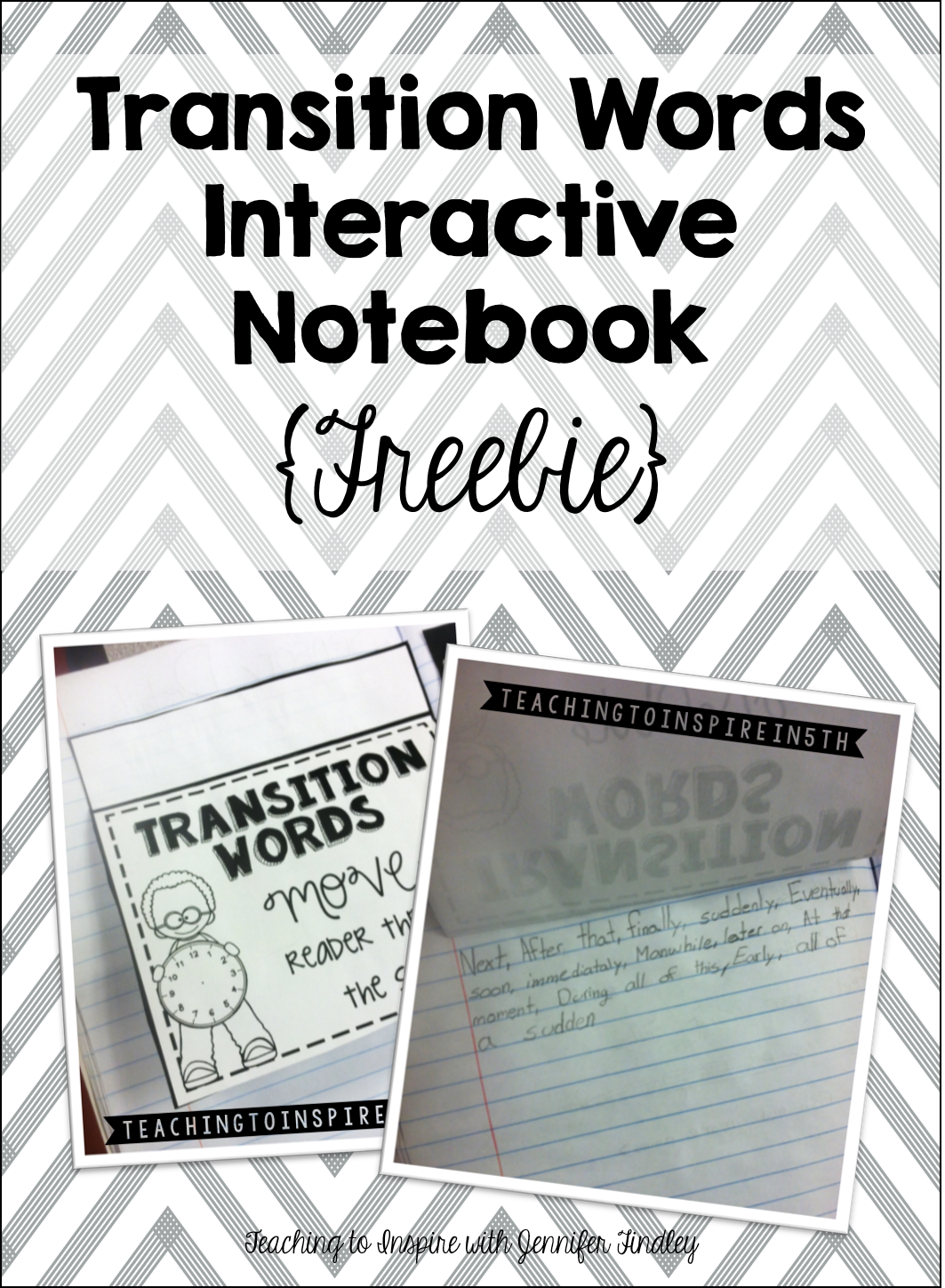
Last week, I did a quick mini lesson on using transition words in writing. We talked about how transition words make stories sound better and help the reader move through the story. We discussed how clear organization is key to a successful story and how transition words are key to having clear organization. We made this anchor chart as a class of some common transition words we have used or have read in our read alouds or independent reading books.
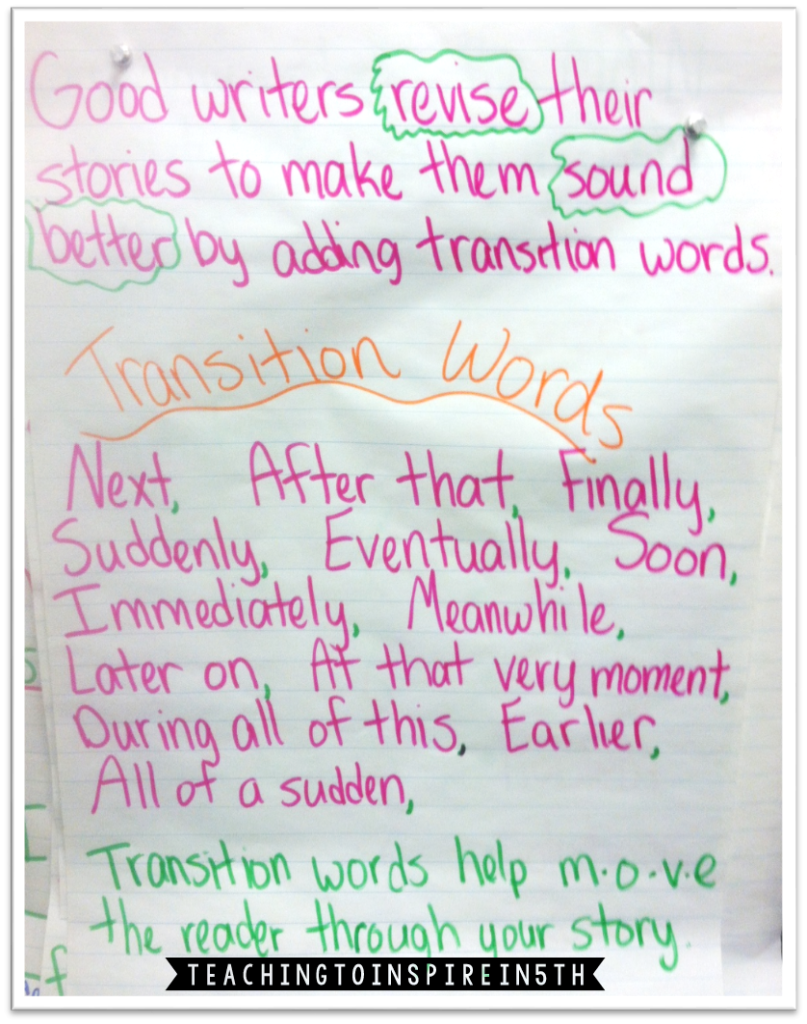
After making the anchor chart together, the students cut and glued this simple foldable in their writing notebook. I love this foldable because of the graphic of the clock that reminds the students of the purpose of transition words in narrative texts and why they should be included in a text.
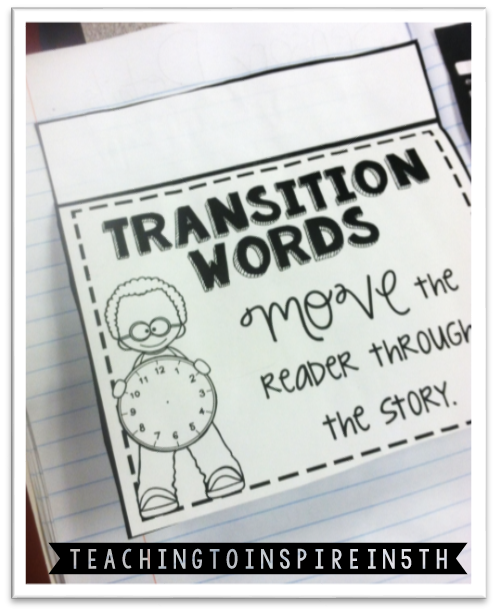
Underneath the flap, the students recorded the words from the chart. They also included any other words that we did not include on the chart. Throughout the year, this will be an ongoing foldable that the students will add to as they discover new transition words that they want to use in their writing. The students will refer to this foldable throughout the year as they are writing narrative texts.
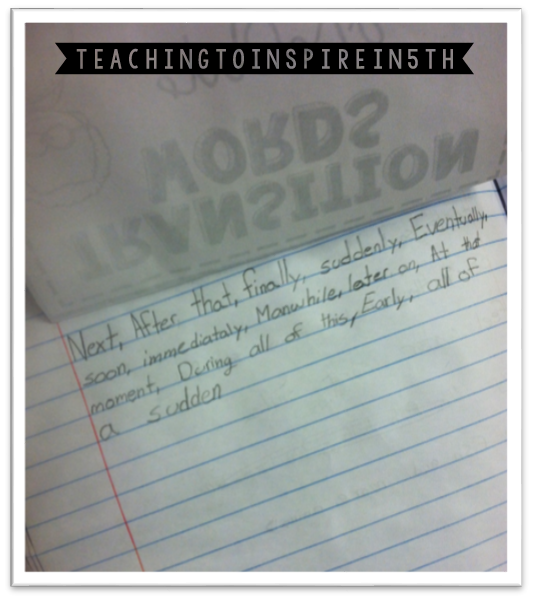
I love quick and easy writing lessons that give the students an “anchor” to make their writing better in the future!
Click on the image below grab the free template from Google Docs. Let me know if you plan to use this foldable!

Share the Knowledge!
Reader interactions.
October 5, 2014 at 5:25 pm
Thank you for this! I can't wait to use it this week 🙂
faithfulinfirst.blogspot.com
October 10, 2014 at 12:39 pm
Great freebie! Thanks. I love that there's room to add more as they discover the words modeled in their reading. makes it a great on-going lesson.
October 12, 2014 at 8:12 pm
I am focussing on transition words right now with my fifth graders too! Great idea!
October 19, 2014 at 11:44 am
I have been teaching transition words over the past couple of weeks, this is perfect!
October 4, 2015 at 7:39 pm
Thank you! I wil use it this week with my students.
Leave a Comment Cancel reply
Your email address will not be published. Required fields are marked *
Notify me of follow-up comments by email.
Notify me of new posts by email.
You may also love these freebies!
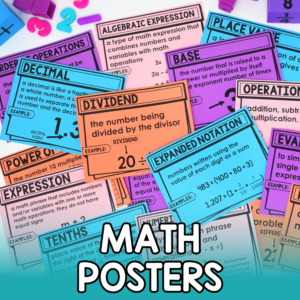
Math Posters
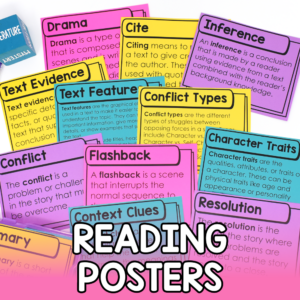
Reading Posters
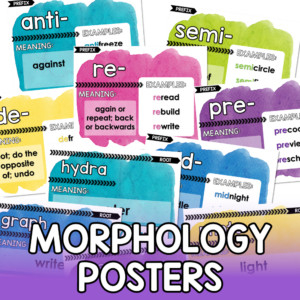
Morphology Posters
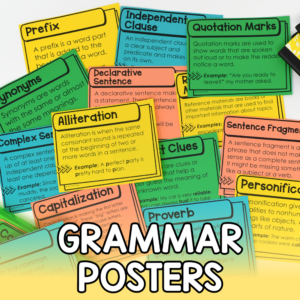
Grammar Posters

Welcome Friends!
I’m Jennifer Findley: a teacher, mother, and avid reader. I believe that with the right resources, mindset, and strategies, all students can achieve at high levels and learn to love learning. My goal is to provide resources and strategies to inspire you and help make this belief a reality for your students.
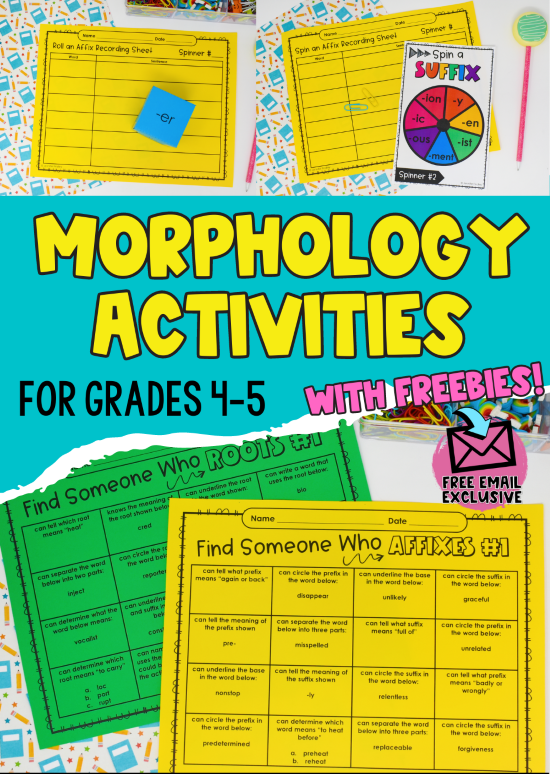
Table of Contents
Collaboration, information literacy, writing process, transitions – transition words – transitional phases.
- © 2023 by Joseph M. Moxley - University of South Florida , Barbara McLain - The Out-of-Door Academy
Transitions are a lifeline for readers, listeners, users —a kind of conceptual superglue . Transition words and traditional phrases are crucial to helping audiences keep track of the author's reasoning and purposes for writing. Learn to identify when transitions are warranted in your work and the work of others. Distinguish between effective and ineffective transitions.

What are Transitions? Transition Words? Transition Phrases?
Transitions, Transition Words , Transitional Phases—these terms concern authors’ efforts to design the flow of information in a text in ways that promote clarity , brevity , simplicity , flow , unity for readers, listeners, users .
Accomplished writers understand interpretation is challenging. They understand readers can lose track of the big picture—the writer’s purpose , thesis , research question . Thus, when revising and editing , writers are careful to check the flow of information across words , sentences , paragraphs . They seek to identify and rewrite choppy spots in their writing when readers ask, “Why am I being given this information? So What? How does this relate to what’s been said thus far?”
Transitions refers to
- the act of shifting the focus in discourse from one idea, process, state, experience to something new
- the convention that writers address information literacy practices and perspectives when they cite textual evidence or empirical evidence
- efforts to clarify a text’s organizational schema,
Transition Words & Phrases are words and phrases (aka signs or signposts) that writers and speakers use to help their readers, listeners, or users understand the flow of information across a text .
Transitional Words refers to elements of spoken and written language (e.g., words, phrases, sentences, paragraphs, and sections) that authors use to help audiences understand the flow of information across a text .
- Transitions may be referred to as sticky points, wounds, seques, gaps
- Transition Words may also be referred to as transitional language , linking language, explanatory language, metalanguage, pivoting, signposting
Related Concepts: Communication ; Information Architecture ; Organization ; Organizational Schema; Rhetorical Analysis ; Rhetorical Reasoning ; Unity
Why Do Transitions Matter?
For readers, listeners, users , transitions are a lifeline —a kind of conceptual superglue . Transition words are crucial to helping audiences keep track of the author’s reasoning and purpose for writing.
At any given moment, people experience a tsunami of information coming at them at warp speed. When reading or listening, people may be distracted by any number of other things—an email, a plane flying overhead, a social media post, a poignant memory, a stock market crash. Their own personal concerns or a nudge from social media may get them off task in a jiffy.
Writers and speakers use transitions to keep the audience’s focus on their narrative , thesis , research question , hypothesis.
Function of Transition Words & Transitional Phrases
Transition words and transition phrases may be categorized by their rhetorical function —aim of discourse, as illustrated in Table 1 below.

Best Transition Words for Essays
The best transition words are the ones that best match your rhetorical situation .
In order to identify the best transition words for an essay you are writing, you should first engage in rhetorical analysis and rhetorical reasoning . Subsequently, you can then make rhetorically informed decisions regarding the appropriate persona , tone , and voice you should adopt when you begin your composition .
Sample Questions for Rhetorical Analysis of Transitions
In order to select appropriate transitions and transitional words for your texts , engage in rhetorical analysis . Ask yourself,
- What is my purpose (aka aim) ? What am I attempting to accomplish?
- If so, you may not even need transitions.
- Then you’ll need extensive transitional language to help your readers follow your reasoning.
- Are there any genre considerations or media considerations that inform your readers’ expectations regarding effective or ineffective uses of transitional language ?
Academic Writing Prose Conventions
Transition words in academic essays and academic writing in general tend
- to use formal diction .
- Academic essays often express transitions in paragraph form at the beginning of texts and interspersed between major sections
- to reflect the information literacy perspectives & practices of their intended audiences.
Template for Transitions in Academic Writing
Below are examples of common transitions in academic writing genres.
Professional Writing Prose Conventions
Transition words in professional writing (aka workplace writing ) are similar to those in academic writing . However, there are a few distinctions: workplace writing tends to rely more on headings and visual language than rely on paragraph-style transitions like those used in academic writing.
Transitions & Invention

For writers, transitions across topics can spark invention . Sometimes when revising, when looking in between sentences and paragraphs to check them for clarity , writers identify breakdowns in their reasoning or gaps in scholarly conversations or discover entirely new things to say.
How to Edit Transitions & Transition Words
Teachers and critic s write Transition? on texts when they
- They don’t understand why they are being told what they are being told.
- believe a t ransitional word or a transitional phrase is superfluous or used incorrectly (see Brevity )
You will find it helpful to examine your use of transition words if you have been told your organization needs work or that your writing is awkward or choppy .
Step 1: Rhetorical Analysis
First, make sure your transitions are appropriate for the rhetorical situation you are addressing. For example, if you are addressing a loved one in a personal note, you would want to use “also” instead of “moreover.”
Check, in particular, the tone and diction level of your transition words.
Step 2: Textual Analysis
When you revise , edit , or proofread your documents, you should consider whether or not you have provided sufficient transition s and transition words .
- between and within sentences : Transitional words or phrases are used to create connections between sentences, as well as within sentences; both uses enhance the progression of ideas at the sentence level .
- between paragraphs : Transitional sentences are used to create a bridge between paragraphs. These sentences should provide a summary of the main idea of one paragraph and give the reader a clue as to what is coming in the next paragraph (Internal link to: relate paragraphs logically to previous paragraph(s).
- between sections : Transitional paragraphs are used in longer works to summarize the discussion of one section and introduce the reader to the concept(s) presented in the next section.
Also, be sure to double check that you have avoided tedious repetition. Remember, when it comes to transition words, less is more. When possible, you want to vary your transition words.
Example of Unvaried transitional language that creates a primer-like style:
We went to the national mall. Then we visited the Air and Space Museum. Then we stopped for lunch at Jaleo.
Varied transitional language : To start the day, we went to the national mall. After a stroll around the reflecting pool, we visited the Air and Space Museum. When we couldn’t walk another step, we stopped at Jaleo for lunch.
Related Concepts
Transitions, Transition Words, Transitional Language — these concepts are intertwined with information architecture , organizational schema (aka organizational scaffolding), and recent research on cognitive development and learning science theory.
Transitions & Transition Words are a major textual attribute of a reader-based prose style , an academic prose style , and a professional writing prose style (aka workplace writing style).
In contrast, writer-based prose lacks needed transitions and transition words .

Brevity - Say More with Less

Clarity (in Speech and Writing)

Coherence - How to Achieve Coherence in Writing

Flow - How to Create Flow in Writing

Inclusivity - Inclusive Language

The Elements of Style - The DNA of Powerful Writing

Suggested Edits
- Please select the purpose of your message. * - Corrections, Typos, or Edits Technical Support/Problems using the site Advertising with Writing Commons Copyright Issues I am contacting you about something else
- Your full name
- Your email address *
- Page URL needing edits *
- Name This field is for validation purposes and should be left unchanged.
Other Topics:

Citation - Definition - Introduction to Citation in Academic & Professional Writing
- Joseph M. Moxley
Explore the different ways to cite sources in academic and professional writing, including in-text (Parenthetical), numerical, and note citations.

Collaboration - What is the Role of Collaboration in Academic & Professional Writing?
Collaboration refers to the act of working with others or AI to solve problems, coauthor texts, and develop products and services. Collaboration is a highly prized workplace competency in academic...

Genre may reference a type of writing, art, or musical composition; socially-agreed upon expectations about how writers and speakers should respond to particular rhetorical situations; the cultural values; the epistemological assumptions...

Grammar refers to the rules that inform how people and discourse communities use language (e.g., written or spoken English, body language, or visual language) to communicate. Learn about the rhetorical...

Information Literacy - Discerning Quality Information from Noise
Information Literacy refers to the competencies associated with locating, evaluating, using, and archiving information. In order to thrive, much less survive in a global information economy — an economy where information functions as a...

Mindset refers to a person or community’s way of feeling, thinking, and acting about a topic. The mindsets you hold, consciously or subconsciously, shape how you feel, think, and act–and...

Rhetoric: Exploring Its Definition and Impact on Modern Communication
Learn about rhetoric and rhetorical practices (e.g., rhetorical analysis, rhetorical reasoning, rhetorical situation, and rhetorical stance) so that you can strategically manage how you compose and subsequently produce a text...

Style, most simply, refers to how you say something as opposed to what you say. The style of your writing matters because audiences are unlikely to read your work or...

The Writing Process - Research on Composing
The writing process refers to everything you do in order to complete a writing project. Over the last six decades, researchers have studied and theorized about how writers go about...

Writing Studies
Writing studies refers to an interdisciplinary community of scholars and researchers who study writing. Writing studies also refers to an academic, interdisciplinary discipline – a subject of study. Students in...
Featured Articles

Academic Writing – How to Write for the Academic Community

Professional Writing – How to Write for the Professional World

Authority – How to Establish Credibility in Speech & Writing

IMAGES
VIDEO
COMMENTS
Here is a list of transition words and how to use them for various literary purposes: 1. Time: These words have to do with sequential transition or chronology and are often used to define time. Some examples of time transition words are "finally," "in the first place," "in the meantime," and "all of a sudden.". 2.
Transition Words/Phrases in Narrative Writing Transitional expressions can help tie ideas together. They also help your narrative flow from one paragraph or idea to the other. Try out a few in your paper. Be sure that any transition you use makes sense. The goal is to make your writing flow smoothly from sentence to sentence. After subsequently ...
Transitional words and phrases can create powerful links between ideas in your paper and can help your reader understand the logic of your paper. However, these words all have different meanings, nuances, and connotations. Before using a particular transitional word in your paper, be sure you understand its meaning and usage completely and be sure…
Misused transition words can make your writing unclear or illogical. Your audience will be easily lost if you misrepresent the connections between your sentences and ideas. Confused use of therefore "Therefore" and similar cause-and-effect words are used to state that something is the result of, or follows logically from, the previous. Make ...
Including transitions helps readers follow a narrative, understand an idea as it develops throughout an essay, and keep up with the logic ... Take a look in at an assignment you are working and fnd places where a transitional word or phrase might improve your writing. A good way to tell if you might need to add a transitional word of phrase is ...
Oliver Olsen learns how to change his own world as the engaging third grader works on a school science project. The telling (third person) is natural and the situations plausible. The story can be retold using transition words to emphasize or identify individuals' favorite (or most memorable) parts. Book Details.
Common Transition Words and Phrases. In an effort to make our handouts more accessible, we have begun converting our PDF handouts to web pages. Download this page as a PDF: Transitions. Return to Writing Studio Handouts. Transitions clarify the logic of your argument by orienting your reader as you develop ideas between sentences and paragraphs.
4 Writing Tips. Transitional words and phrases in fiction, as in nonfiction, aid smooth movement between paragraphs, chapters, scenes, ideas, locations, times and characters. Effective transitions act as bridges that move the reader logically from one point to another, unobtrusively, without awkwardness. They may use special "transition" words ...
Transition words help make writing flow smoothly, connecting ideas, sentences, and paragraphs. Transition words in narrative writing often indicate sequence, time, or place. In this language and vocabulary worksheet, learners will read short narrative passages and choose the transitions that best connect the ideas and sentences. Designed for a ...
Transition words create cohesion and improve writing flow, helping audiences stay focused on your argument or narrative as you move between sentences, paragraphs, or sections of your work. Without transition words and phrases, writing can feel like trying to move across a broken bridge as you navigate a series of unconnected ideas.
Tips for students on writing a Narrative / Descriptive essay. While this guide is not comprehensive, it does provide enough information for to students to follow and pass the assignment. ... Adding Transitions: Narrative Essay. Narrative Essay. Narrative (Timeline) Transitions. Helpful Transitional Expressions. Transitional expressions can help ...
Transitions. Transitions help your readers move between ideas within a paragraph, between paragraphs, or between sections of your argument. When you are deciding how to transition from one idea to the next, your goal should be to help readers see how your ideas are connected—and how those ideas connect to the big picture.
33 Transition Words and Phrases. 'Besides,' 'furthermore,' 'although,' and other words to help you jump from one idea to the next. Transitional terms give writers the opportunity to prepare readers for a new idea, connecting the previous sentence to the next one. Many transitional words are nearly synonymous: words that broadly indicate that ...
Temporal Words/Phrases for Narrative Writing These words must be followed by a comma! After subsequently at first As soon as first it began Before second it started Next once after that ... Transition Words/Phrases for Narrative Writing Author: lel1 Created Date:
Use transition words in narrative writingIn this lesson, you will learn how to guide your audience through your story by using transition words.ADDITIONAL MA...
Transitions. Transitions are the bridges between parts of your paper. They help to create both coherence and cohesion in a paper (aka "flow"), and they enable the reader to make the logical connections between the writer's ideas in the way that the writer intends. Transitions help carry a thought from sentence to sentence, one idea to ...
Transition sentence This paragraph… Further evidence in support of this hypothesis is provided by Smith (2019). …complements the previous one, providing more support for the same idea. However, Patel's arguments are not the final word on the matter. …contradicts the previous one by presenting new evidence related to the previous discussion. Having established the relationship between ...
Transition Words {Interactive Notebook} Freebie! Last week, I did a quick mini lesson on using transition words in writing. We talked about how transition words make stories sound better and help the reader move through the story. We discussed how clear organization is key to a successful story and how transition words are key to having clear ...
Transitions are a lifeline for readers, listeners, users—a kind of conceptual superglue. Transition words and traditional phrases are crucial to helping audiences keep track of the author's reasoning and purposes for writing. Learn to identify when transitions are warranted in your work and the work of others. Distinguish between effective and ineffective transitions.
Engage the class in discussion by asking, "When you start reading the directions, does it ever say, 'Last, add the sugar. Next, crack the eggs. First, pour in the flour'?" Challenge students to think about why these directions are not correct. Invite a volunteer put the directions in the correct order. Ask the volunteer to explain how they know ...
Transition words between areas or subjects: When writing longer narratives or assessments, students might use transition words to move between topics or subjects. Transitions between paragraphs: If you are writing in multiple paragraphs, you might need to use particular order transition words between paragraphs to guide the reader clearly ...